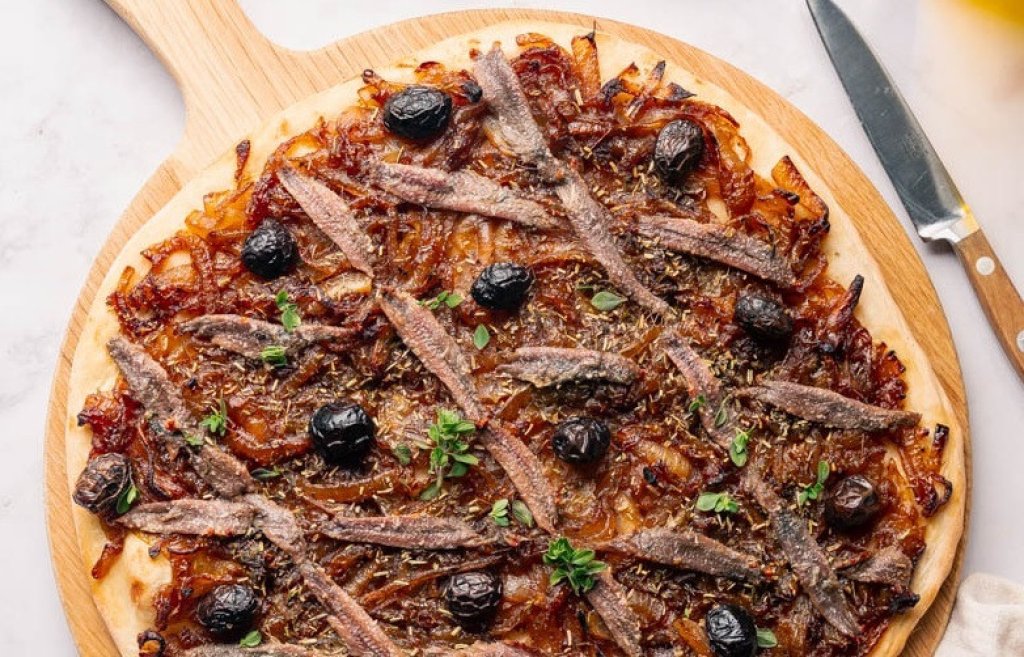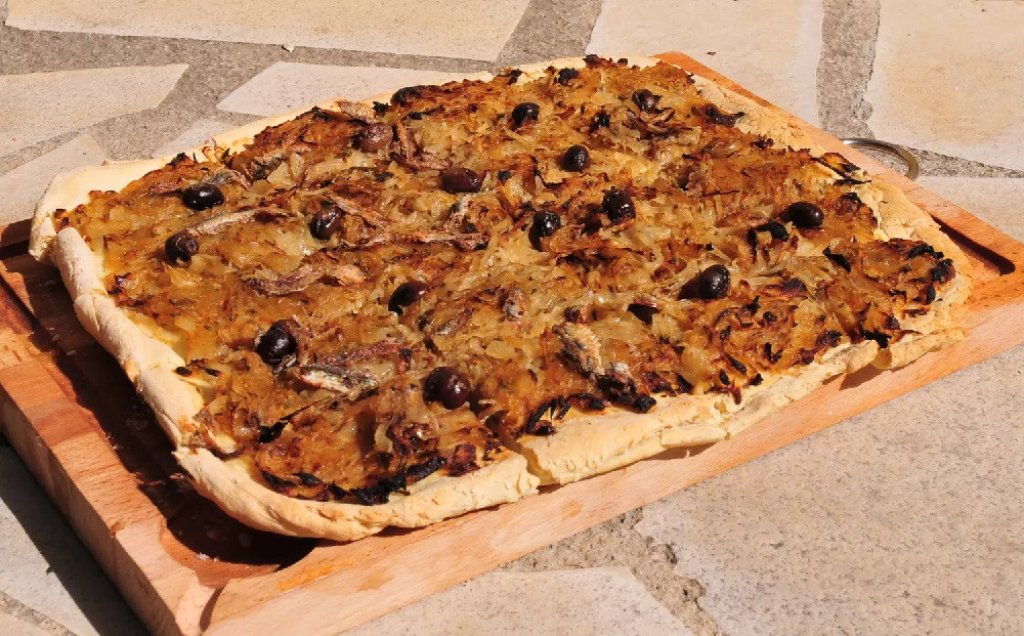Looking for the authentic recipe for Provençal pissaladière? This savory tart, emblematic of Nice and its region, will awaken your taste buds. The traditional recipe combines caramelized onions, anchovies, and black olives on a bread dough base.

Authentic pissaladière is made with sourdough from the baker. Its name comes from pissalat, a thick sauce made from sardines and/or anchovies. Olive oil adds flavor to the whole dish.
The onions must be simmered for at least 2 hours. The onions are ready when they can be mashed with a fork without browning. Then bake the dough in the oven at 410°F.
Allow 1 hour 45 minutes to 2 hours to make this recipe. Nice cuisine requires patience, but the result is delicious. This gourmet dish from the south of France is the perfect accompaniment to your aperitifs.

Ingredients for 6 people
For the bread dough
500 g type 55 or 65 flour
15 g fresh baker's yeast (or 7 g dry yeast)
15 to 20 cl lukewarm water
3 cl olive oil
5 g fine salt
For the topping
2 kg fresh white onions or spring onions
2 cloves of garlic
100 ml olive oil
12 salted anchovy fillets (desalted) or anchovies in oil
24 black olives from Nice
1 bouquet garni (thyme, bay leaf, rosemary)
Salt and freshly ground pepper
Preparation time
Preparation: 30 minutes
Dough resting time: 1 hour 30 minutes
Cooking time: 45 minutes (onions) + 25 minutes (oven)
Total: about 3 hours 30 minutes

Step-by-step recipe
Preparing the bread dough
Pour the flour into a large bowl and make a well in the center.
Add the salt, baker's yeast, olive oil, and cold water to the well.
Mix first with your fingers, then knead vigorously for 10 to 15 minutes. The dough should become smooth, elastic, and uniform in texture.
Shape the dough into a ball. Place it in a lightly oiled bowl and cover with a clean cloth.
Let the dough rise for 1 hour and 30 minutes at room temperature. It should double in volume.
Preparation of the onion filling
Finely chop the 2 kg of white onions. Peel the onions, leaving the root intact to make them easier to chop.
Heat the olive oil in a heavy-bottomed casserole dish. Add the chopped onions with the whole garlic cloves and the bouquet garni.
Cover and simmer for at least 2 hours over very low heat. The onions should melt without taking on any color.
After 20 minutes of cooking, add 6 anchovy fillets, which should melt into the onions. Season lightly with salt and pepper.
Assembly and baking
Preheat the oven to 210°C (thermostat 7).
Spread the dough by hand on a baking sheet lined with parchment paper. Form a rim to hold the filling.
Spread the onions, while still hot, over the dough to stimulate rising. Let rest for 20 minutes.
Bake the dough alone for 10 minutes.
Remove the baking sheet from the oven without turning it off. Spread the onion compote evenly over the pre-baked dough.
Arrange the remaining anchovy fillets in a grid pattern and place the black olives in the squares formed.
Return to the oven and bake for 20 to 25 minutes, until the dough is golden brown.
Remove from the oven, sprinkle with fresh thyme and season with freshly ground pepper.
Serve warm or at room temperature, cut into rectangular pieces. This Nice specialty is perfect as an appetizer or starter.
This traditional Provençal recipe requires patience, but the result will transport you straight to sunny Nice.
How to serve pissaladière?
Pissaladière can be served hot or cold, depending on your preference. It is delicious as a starter, appetizer, or main course. For a successful appetizer, cut it into small squares that your guests can easily pick up.
This Mediterranean topping goes perfectly with a green salad for a light summer meal. The traditional garnish of anchovies and black olives makes each slice a true little Provençal painting.
It is an ideal dish to share with family or friends. It can be enjoyed as a starter, warm or cold, depending on individual preferences. Good wines to accompany it are a Provence rosé or a dry Bellet white.
What is the origin of pissaladière?
The origin of this Nice specialty dates back to the Middle Ages. According to sources, this recipe originated in the Genoa region of Italy, inspired by the 16th-century piscialandrea. It is part of Nice's cultural heritage, along with socca and pan-bagnat.
This culinary tradition then spread throughout Provençal cuisine. The first written records of pissaladière date back to the 19th century, under the name ‘pissalat à la niçoise’. The history of this dish is linked to pissalat, an anchovy paste that gave it its name.
Nice's gastronomy has made this recipe a symbol of the Mediterranean way of life. The secret of the recipe has been passed down from generation to generation in Nice families. It has become a source of local pride, representing the culinary identity of the County of Nice.
How can you adapt the pissaladière recipe?
You can easily adapt this recipe to suit your tastes. For a quicker version, use store-bought pizza dough or order it from your baker. Frozen onions will save you time on peeling.
There are many variations to personalize your pissaladière. For a more original version, replace the yellow onions with red onions. You can add cherry tomatoes or sun-dried tomatoes for a revisited recipe.
For an easy recipe without anchovies, replace them with tapenade or sardines. Shortcrust or puff pastry are perfect substitutes for pizza dough. The pichade de Menton even adds tomato sauce to the traditional recipe for an even more indulgent version.
Discover all our Provençal recipes :
not forgetting our Provençal dessert recipes :













